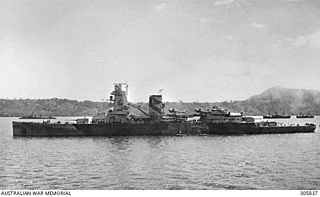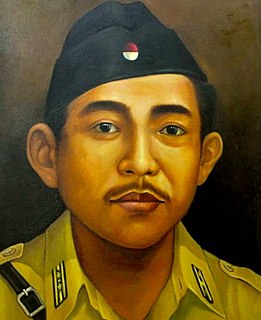
Balinese Hinduism is the form of Hinduism practiced by the majority of the population of Bali. This is particularly associated with the Balinese people residing on the island, and represents a distinct form of Hindu worship incorporating local animism, ancestor worship or Pitru Paksha, and reverence for Buddhist saints or Bodhisattava.

Mount Agung is an active volcano in Bali, Indonesia, southeast of Mount Batur volcano, also in Bali. It is the highest point on Bali, and dominates the surrounding area, influencing the climate, especially rainfall patterns. From a distance, the mountain appears to be perfectly conical. From the peak of the mountain, it is possible to see the peak of Mount Rinjani on the nearby island of Lombok, to the east, although both mountains are frequently covered in clouds. Agung is a stratovolcano, with a large and deep crater. Its most recent eruptions occurred from 2017–2019.

The Battle of Badung Strait was a naval battle of the Pacific campaign of World War II, fought on the night of 19/20 February 1942 in Badung Strait between the American-British-Dutch-Australian Command (ABDA) and the Imperial Japanese Navy. In the engagement, the four Japanese destroyers defeated an Allied force that outnumbered and outgunned them, sinking the Dutch destroyer Piet Hein and escorting two transports to safety. The battle demonstrated the Japanese Navy's considerable superiority over the Allies in night fighting which lasted until the Battle of Cape St. George.

Hinduism in Indonesia, as of the 2018 census, is practised by about 1.74% of the total population, and almost 87% of the population in Bali. Hinduism is one of the six official religions of Indonesia. Hinduism came to Indonesia in the 1st-century through traders, sailors, scholars and priests. A syncretic fusion of pre-existing Javanese folk religion, culture and Hindu ideas, that from the 6th-century also synthesized Buddhist ideas as well, evolved as the Indonesian version of Hinduism. These ideas continued to develop during the Srivijaya and Majapahit empires. About 1400 CE, these kingdoms were introduced to Islam from coast-based Muslim traders, and thereafter Hinduism mostly vanished from many of the islands of Indonesia.

Tanah Lot is a rock formation off the Indonesian island of Bali. It is home to the ancient Hindu pilgrimage temple Pura Tanah Lot, a popular tourist and cultural icon for photography.

Buleleng is a regency (kabupaten) of Bali, Indonesia. It has an area of 1,365.88 km2 and population of 624,125 at the 2010 Census and 791,910 at the 2020 Census. Its regency seat is at the town of Singaraja.

Danghyang Nirartha, also known as Pedanda Shakti Wawu Rauh, was a Shaivite religious figure in Bali and a Hindu traveler during the 16th century. He was the founder of the Shaivite priesthood in Bali.
Anak Agung Bagus Suteja was the first governor of Bali, appointed by President Sukarno in 1958, when Bali became a province.He was the son of the last Raja of Jembrana, Anak Agung Bagus Negara.
Hotel Tjampuhan & Spa, better known as the Tjampuhan Hotel is a historic hotel in Ubud, on the island of Bali, Indonesia. The Tjampuhan is the second-oldest hotel in Bali, trailing only the Natour Bali Hotel that opened in 1927. It is run and owned by the Tjampuhan Group under Tjokorda Oka Artha Ardhana Sukawati and his family.

The Klungkung Palace, officially Puri Agung Semarapura, is a historical building complex situated in Semarapura, the capital of the Klungkung Regency (kabupaten) on Bali, Indonesia. The palace (puri) was erected at the end of the 17th century, but largely destroyed during the Dutch colonial conquest in 1908. Today the basic remains of the palace are the court of justice, the Kertha Gosa Pavilion, and the main gate that bears the date Saka 1622. Within the old palace compound is also a floating pavilion, the Bale Kembang. The descendants of the rajas that once ruled Klungkung today live in Puri Agung, a residence to the west of the old palace, which was built after 1929.

Puputan is an old Javanese loanword or term for mass ritual suicide in preference to facing the humiliation of surrender. Notable puputans in the history of Bali occurred in 1906 and 1908, when the Balinese were being subjugated by the Dutch.

Colonel I Gusti Ngurah Rai was an Indonesian National Hero who commanded Indonesian forces in Bali against the Dutch during the Indonesian War of Independence. He was killed in the Battle of Margarana.
Gelgel is a village (desa) in the regency (kabupaten) of Klungkung, on Bali, Indonesia. The village, near the coast four kilometers south of the regency capital Semarapura, contains a number of structures of cultural interest, and is known for its pottery and handwoven ceremonial songket cloth. The height of the village's power came during the kingdom of Gelgel, which dominated Bali from around the early 16th century to 1686. There are no traces left today of the old royal palace (puri). The old ancestral shrine of the ruling dynasti, Pura Jero Agung, is still standing in the old palace area. To the east of Pura Jero Agung is another old temple, Pura Dasar, which is a lowland counterpart of the "mother temple" of Bali, Pura Besakih. The village also contains the oldest mosque in Bali, which was built by Javanese retainers of the old kings.

Goa Gajah, or Elephant Cave, is located on the island of Bali near Ubud, in Indonesia. Built in the 9th century, it served as a sanctuary.

The Moon of Pejeng, also known as the Pejeng Moon, in Bali is the largest single-cast bronze kettle drum in the world. and "the largest known relic from Southeast Asia's Bronze Age period." It is "considered highly sacred by local people." It is thought to be a relic of early rice cultivation rituals.

Pura Ulun Danu Beratan, or Pura Bratan, is a major Hindu Shaivite temple in Bali, Indonesia. The temple complex is on the shores of Lake Bratan in the mountains near Bedugul. The water from the lake serves the entire region in the outflow area; downstream there are many smaller water temples that are specific to each irrigation association (subak).
I Gusti Ketut Jelantik (-1849) was a Balinese Prime Minister of the state of Buleleng, who resisted the imposition of Dutch treaties.

Pura Penataran Sasih is a Hindu temple in Pejeng village, Bali. It was founded, according to a modern chronogram displayed at the entrance, in 1266 AD, and served as the state temple of the Pejeng Kingdom, 1293 - 1343 AD.

I Gusti Ngurah Rai International Airport, is the main airport in Bali, located 13 km south of Denpasar. Ngurah Rai is the second busiest airport in Indonesia after Soekarno–Hatta International Airport. In 2018, the airport served 23,779,178 passengers. The airport has category IX and is capable of serving wide-body aircraft including the Boeing 747-8 and Airbus A380.
The Battle of Margarana was a battle fought between the Netherlands Indies Civil Administration (NICA) and the recently created, rebelling Ciung Wanara Battalion that occurred in Marga, in Bali Indonesia.















